
Specs at a glance: HTC One A9 Screen 5-inch, 1080p AMOLED, Gorilla Glass 4 OS Android 6.0 Marshmallow CPU Snapdragon 617, 64-bit octa-core Cortex A53: 4 cores @ 1.5GHz; 4 cores @ 1.2GHz RAM 2GB (3GB in 32GB storage model) GPU Qualcomm Adreno 405 GPU Storage 16GB or 32GB, plus micro SD expansion Networking 802.11 Wi-Fi a/b/g/n/ac (2.4 & 5 GHz) Ports Micro USB, headphone jack Camera 12MP rear camera, 4MP HTC ultrapixel selfie camera Size 145.75mm length, 70.8mm width, 7.26mm depth Weight 143g Battery 2150mAh Network Bands 2G: 850/900/1800/1900MHz, 3G: 850/900/AWS/1900/2100MHz, 4G (EMEA/Asia): FDD bands 1, 3, 5, 7, 8, 20, 28, TDD bands 38, 40, 41, 4G (USA): FDD bands 2, 3, 4, 5, 7, 12, 13, 17, 29 Other perks Quick Charge 3.0 support, 24-bit DSP and DAC, RAW image support Price $399 direct from HTC.com (introductory period only; $400 thereafter) / £430
Oh, HTC: you got so very, very close with this one. In some ways, the HTC One A9 is an excellent mid-range phone. It sports a 5-inch screen, a size many—myself included—consider an ideal balance between screen size and practicality. It's plenty fast, if not outrageously so, thanks to its Snapdragon 617 SoC and 2GB (or 3GB if you're in the US) of memory, while its camera is capable of taking some great photos—it even has a micro SD card slot for cheap storage expansion. And yes, while there's no question that the A9's design is derivative of a certain fruit-based company's leading smartphone, it is still a gorgeous thing to look at. Like all phones in the HTC One lineup, it's well-built too.
But man, the battery life is a killer. After years of poor battery life on Android, I finally thought we were past the point of phones dying during your evening commute. There's also the small matter of price. In the US, at $399 for an unlocked edition of the phone—complete with 32GB of storage, 3GB of RAM, an unlocked bootloader, less pre-installed software, six-months of free Google Play Music, and 12-months of HTC's Uh Oh protection—the A9 and its classy, all-metal body is definitely worth a look, despite the poor battery life. However, at £430 ($660!) in the UK—that's more than the faster M9, and just £30 less than an iPhone 6—for a 16GB version with 2GB of memory and none of the extra goodies, it's unquestionably awful. Don't buy this phone if you live in the UK.
Design
The UK price is such a shame, because I do really like this thing. A lot of it is down to the design, and HTC's build quality. The A9 is as close as you're going to get to owning a phone with the looks of an iPhone—with similar colour choices, too: Carbon Grey and Deep Garnet (red) with black fascias, and Opal Silver (pictured) and Topaz Gold with white fascias—and the flexibility of Android. Side-by-side with Apple's phone, the resemblance is uncanny, and as I put it through its paces during testing, lots of people said they thought I was using an iPhone until they caught a glimpse of the HTC logo. It even feels the same when you use it, thanks its smooth curved corners, and glass that tapers in at the edges. It weighs exactly the same as an iPhone 6S at 143g.
HTC has long had some of the best-looking Android phones in the business, based on its own unique design language. And while it's sad to see some of that disappear in the A9—the Boomsound speakers, the curved back, and the big camera cut-outs—I'll admit that having an iPhone-like design with Android on it is appealing. The A9 is thin (7.2mm), and light, and immensely practical. The fingerprint sensor below the Gorilla Glass 4 screen is super-fast and accurate, and I like that it doubles up as a home button and a way to wake the screen up from sleep. I like the subtle speaker grille on the bottom of the phone, too, along with all the ports and buttons that feel like they've carved out of a solid block of aluminium.

The HTC One A9 in all its shiny glory.

The HTC One A9 in all its shiny glory.

From left to right: HTC One A9, HTC One M9, Google Nexus 5, Sony Xperia Z3 Compact

From left to right: HTC One A9, HTC One M9, Google Nexus 5, Sony Xperia Z3 Compact
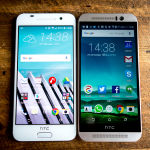
The A9 is roughly the same size as the M9.
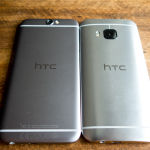
The A9 continues to feature HTC's trademark antenna lines.

The A9's camera module has been given an iPhone-like makeover.
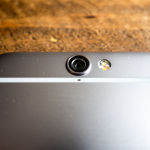
With OIS and a wide f/2,0 aperture, the A9's camera can take great photos.
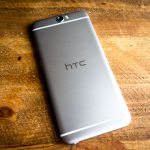
The rear of the A9 is simple, but attractive.

Who needs boomsound speakers anyway?

The bottom of the phone features a fingerprint scanner that doubles up as a home button.

Nothing up top but a piece of plastic for the wireless gear.

On the right of the phone is a heavily textured power button and a volume rocker.

Speaker, headphone jack, and micro-USB port on the bottom.

On the left side of the phone are the microSD and sim card slots.

The A9 versus the M9.

The A9 versus the Nexus 5.
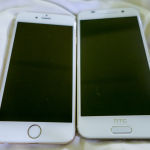
The A9 next to a gold iPhone 6.

See the resemblance yet?
I like that HTC has finally given the power button a noticeably different texture to the volume rocker above it, even if it'd better if the rocker was on the opposite side of the phone. That's where the SIM card and micro SD card (up to 1TB) trays live. I even like the smaller, subtler camera module on the back, as iPhone-like as it is, and that it's centred rather than tucked away to the side. I really like the 5-inch AMOLED screen. It's super sharp thanks to a 1080p resolution (working out to 440 PPI), and it's vibrant and colourful without being over-saturated in the way that Samsung's Super AMOLED screens can be.
And I love the headphone amp and audio on this thing. While I'd suggest turning off the Dolby enhancements (it's a bit too artificial for my ears), the 24-bit DAC and DSP do a great job of turning those 1s and 0s into tunes, while the super-loud headphone amp is able to drive demanding cans and buds without needing to crank the volume, which often results in amplifier distortion. I wish more smartphone makers put as much effort into audio as HTC has with the A9; it really does make a difference.
If you're in the US, this sort of build quality at a $400 price point is rare. Plastic, rather than aluminium is usually the order of the day. If the A9 does nothing else but encourage smartphone makers to up their build-quality game at the mid-range, then it'll have served a fine purpose. If you're in the UK, well, the A9 is still a solid thing... it's just that you're paying a flagship price for a phone with less than flagship specs.
Software
Specs aren't everything, of course, and while I'll go into more detail about the A9's performance later, I will say that I never once lamented that there's only a mid-range SoC in this phone. Partly, it's probably down to what has to be the lightest version of HTC Sense yet. The company is making a rather big hoohah about having worked closely with Google to get Android 6.0 Marshmallow on the A9 at launch, and that relationship has paid dividends when it comes to getting rid of crap software that no one really needs. Gone are the HTC versions of gallery apps, and music apps, and all the other stuff that either Google bundles in with Android, or that users can grab a far superior version of from the Google Play Store.
There are other welcome tweaks, too, including the pull-down notifications shade, which is the stock Marshmallow one, and the fact that you can finally do a standard Google restore from another device, rather than be forced to use HTC's own proprietary software. And, in small but extremely welcome victory for me at least, you can finally add Exchange accounts to the Gmail and Google Calendar apps, instead of being forced to use HTC's own mail app, and all without going through some inane system-level tweaks. Quite why HTC (and indeed Sony and others) forced users to do this, I'll never know.
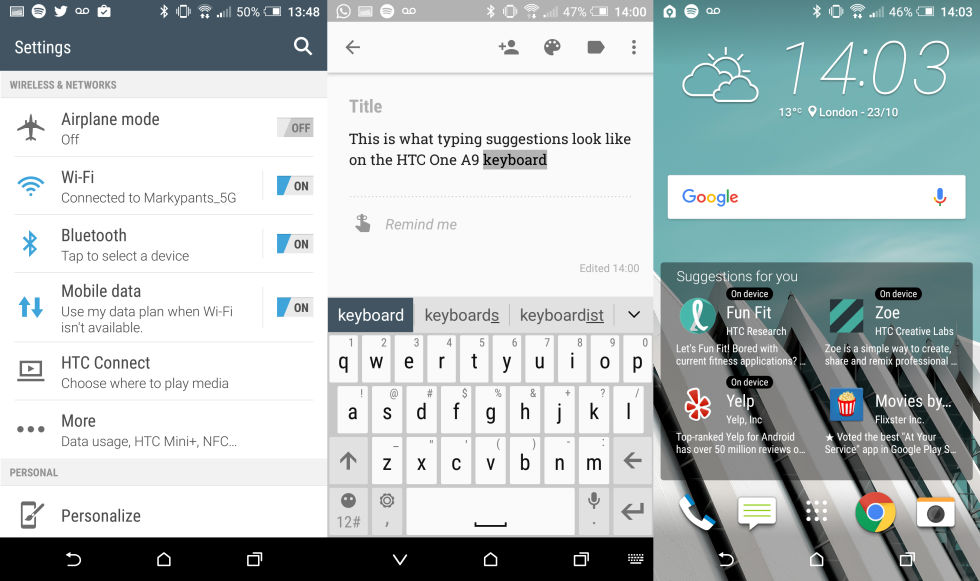
While the latest version of HTC Sense is closer than ever to stock Android, there are still elements of Sense spread across the settings menu, keyboard, and home screen.
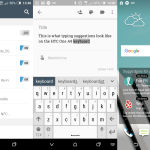
While the latest version of HTC Sense is closer than ever to stock Android, there are still elements of Sense spread across the settings menu, keyboard, and home screen.

Blinkfeed also makes a return, although, it's easily removed if you don't like it. If you do stick with HTC's home screen you can use of the many free user-created themes available.

One of the best things about Android 6.0 is the ability to merge the SD card with internal storage.

The camera UI features lots of options, but is simple to use.
HTC Sense hasn't completely shed all its Android customisations, but what's left is completely liveable and/or removable. Blinkfeed and its social network news feed is still there for those that like it, along with the "smart home screen" that changes icons based on your location, but you can just as easily swap over to the stock Google Now launcher or any other launcher and be done with it. Same goes for the otherwise decent HTC keyboard. With those swapped out, really all you're left with is the HTC lock screen—which is pretty close to stock anyway—along with a few Sense remnants like the settings menu, which still sports HTC's thin and tall fonts and blue and grey colour scheme.
Further Reading

Android 6.0 Marshmallow, thoroughly reviewed
Marshmallow brings a lot of user-requested features but still has no update solution.
If you do opt to use the Google Now launcher, you even get your stock icons back (something that unfortunately doesn't happen with Huawei's Emotion UI, for instance). Those that stick with Sense can at least switch things up thanks to the theme store, which has proved oddly popular. HTC boasts that there have been 7.1 million downloads of themes and that it's seen some 5.5 million unique users. Whatever the stats, there are lots of themes on the store, most of which are free, and most are of a good quality. There are several "stock" themes, too, which replicate the stock Android look across several different versions.
That the latest version HTC Sense is so close to stock means that you essentially get a stock Android experience when you use it. The A9 is one of the first phones outside the Nexus range to get Android Marshmallow, which is something of an iterative improvement, rather than the drastic overhaul that Lollipop was. That's not to say it doesn't have some incredibly useful new features, though. For the full skinny on Marshmallow, I definitely recommend checking out Ron Amadeo's excellent review, but there was one Marshmallow feature that impressed me greatly: proper SD card support.
If you're unlucky enough to be lumped with the 16GB version of the A9, over 8GB of that is going to be taken up by the OS alone. That doesn't leave a whole lot for apps and media. Thanks to Marshmallow, you just stick a micro SD card in the phone, after which you can use it as permanent internal storage by integrating it with the existing storage drive. No longer must you tell the camera to store photos on the SD card, or manually move apps over (for those apps that could be moved over, anyway). It's exactly like having a phone with lots of internal storage, which is exactly how SD cards should have been handled by Android in the first place.
Camera
HTC's made quite the fuss about the camera in the A9, and with good reason: it's by the far the best one HTC has ever put in a phone. It boasts a backside illuminated (BSI) sensor with optical image stabilisation (OIS), f/2.0 aperture, sapphire glass lens cover, and a solid 13-megapixel resolution. It supports up to 1080p video recording (sorry 4K fans), hyperlapse recording, and a pro mode that allows for RAW capture and editing. The selfie cam is the same old 4MP UltraPixel sensor that I found does extremely well in low light.

The A9 fares well in good light, with lots of detail in the shot.

The A9 fares well in good light, with lots of detail in the shot.

The M9 does pretty well here too, although the shot has a slightly warmer tinge to it.

The Nexus 5 overexposes parts of the toys, while also looking washed out.

The Z3 Compact shot looks soft.

This is a tricky shot, and while the A9 overexposes the section by the blinds, the toys themselves look good.

This is a tricky shot, and while the A9 overexposes the section by the blinds, the toys themselves look good.

The M9's shot is much noisier, although the warmer colours look better here.

The Nexus 5 is a washed out, soft mess.

The Z3 Compact doesn't do as well here, with the camera's image processing leaving the picture looking soft.

The A9's flash isn't great, but it'll work in a pinch.

The A9's flash isn't great, but it'll work in a pinch.

It's a similar story for the M9.

The Nexus 5 shot is just plain bad.

The Z3 Compact shot is washed out, and overly soft again.
On paper then, the A9's camera should be a beauty, and it does indeed take some really good pictures, provided it has enough light. The shots I took around the streets of Paris (I'm out attending Paris Games Week at the moment, so apologies if you're not a fan of classic French art and architecture) are sharp and detailed, and sport good colour accuracy too. Tap-to-focus was quick and painless, as was the time to take a photo; I never found myself cursing the phone for being too slow to capture a particular moment, which is almost as important for a camera as the quality of the images themselves.
In trickier situations, such as the dark interior of a church, the point-and-shoot auto mode did struggle a little with exposure, leaving the windows at the top of the scene blown out, and the rest of the shot a little dark. Admittedly, that's a tough one for many a camera's auto mode, and the photo is still plenty sharp and usable. Unfortunately, as the light dies down, so too does the camera's quality. Don't get me wrong: it's still miles ahead of the M9's camera in low light. But the focusing is slower, the ISO noise is higher, and the while the OIS definitely helps, I still had to take a few shots before I got one that didn't come out blurry.






















While the A9's camera isn't a total winner, it's still leaps and bounds ahead of what HTC's put out before, and certainly at the upper end of the Android camera scale, even if it can't compete with the likes of Samsung, Sony, and even Google (thanks to the Nexus 5X and 6P). Plus, the camera UI is simple and effective, even with the manual ISO, white balance, and exposure settings turned on. RAW support is an extremely welcome addition, too. Just make sure you've got a decent size memory card in place—those larger RAW file sizes add up quickly.
Performance
The A9's performance won't blow your socks off—particularly if you're into your benchmarks—but in day-to-day use it's fast enough, and won't melt through your hand in the same way that those early M9s did. The Snapdragon 617 gives you eight 64-bit A53 cores in total (the A53 being the lower-power cores used in the Snapdragon 810 of the M9), four running at 1.5GHz, and another four at 1.2GHz, along with an Adreno 405 GPU. Oddly enough, in Geekbench, the A9 actually beat the M9 in the multicore test. This could be a result of the M9's heavy throttling at work, or it could be Android Marshmallowgiving it something of an advantage. Regardless, it's not a huge victory, and in all other tests, the A9 comes in at the bottom of the pack.
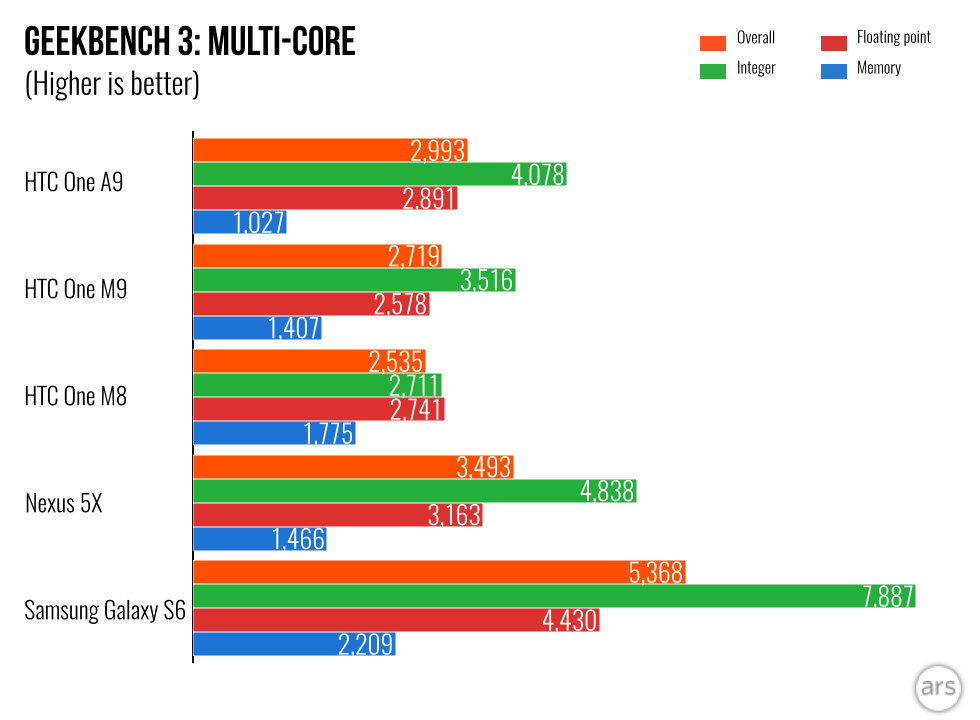
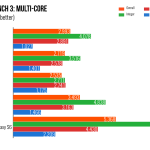


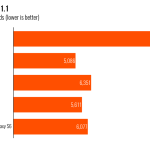


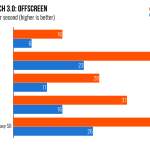



But if the A9's performance is evidence of anything, it's that we're way past the point of needing super-fast processors to get a smooth Android experience. The mid range is the new hotness, and the A9 is proof that you don't have to sacrifice usability to get there. Well, almost: unfortunately, HTC has stuck a puny 2150mAh battery inside the A9, which has resulted in poor battery life. No, it's not the worst on the market in terms of synthetic benchmarks at least, but in use, I found myself reaching for the charger by around 6pm, which meant that if I was going to spend the evening out drinking a sensible number of spirituous beverages and wanted to make sure I got in an Uber afterwards, I'd have to top up the phone during the day.
While I'll admit I've been slightly spoiled by the killer battery life of the Sony Z3 Compact in the past, scraping through to the early evening isn't ideal. If the A9 had managed to get through a whole day, a proper whole day without needing a top-up, I could easily recommend it as one of the top mid-range phones, if not the top mid-range phone on the market, save for maybe the Nexus 5X. As it is, you have to decide whether the A9's sleek styling and solid hardware is worth the battery life sacrifice.
Why can't we have nice things in the UK, HTC?
In some ways, it's sad to see HTC resorting to putting out a device that is so obviously inspired by the iPhone: the company had a great design language of its own after all. With the A9 it's kicked a lot of it to the wayside in favour of making a device with a design that it knows will sell—just look at how many iPhones Apple shifts every quarter. For those not impressed with iOS or the iPhone's higher price tag, the A9 is an appealing option. Besides which, it's not like HTC is the only company that takes inspiration from others—those antenna lines on the iPhone are very much a HTC-inspired bit of design.
Further Reading
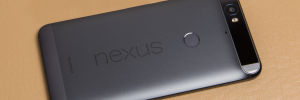
Nexus 5X and Nexus 6P review: The true flagships of the Android ecosystem
With little-to-no compromise, these are now the Android phones to beat.
Taken on its own terms, though, the A9 is a good, sometimes even great phone. It has the camera, the screen, and the build quality to put it up there with flagship phones costing far more money. And with Android Marshmallow, HTC has finally begun to ditch the bloatware, and embrace a more stock Android experience. No other manufacturer at this price point (in the US) can boast a phone of similar build quality to the A9. That's where HTC's strength lies, and where I hope it will focus its efforts in the future, rather than go back to software gimmicks.
Of course, this is all elementary if you live outside of the US. Frankly, UK customers are getting totally shafted on the price of the A9. It's much smarter to spend the extra £30 to get an iPhone if you like the look, or save a little cash and get a Nexus 5X, which has a superior camera, battery life, and totally stock Android if you don't.
The Good
Excellent build quality and materials Vibrant full HD AMOLED screen Seriously powerful headphone amplifier HTC's best camera to date Slimmed down HTC Sense software makes the A9 much closer to stock Android Good price (in the US) The Bad
Battery barely scrapes through to the early evening In very low light, the camera still struggles The Ugly
That UK price. Seriously, what's the deal HTC? Verdict
If you can live with the battery life, the HTC One A9 is a good, almost great mid-range phone with killer looks and a premium build quality. Wait for a price drop if you're in the UK, though.
This post originated on Ars Technica UK
Source:
HTC One A9 review: An awesome mid-range phone (in the US)
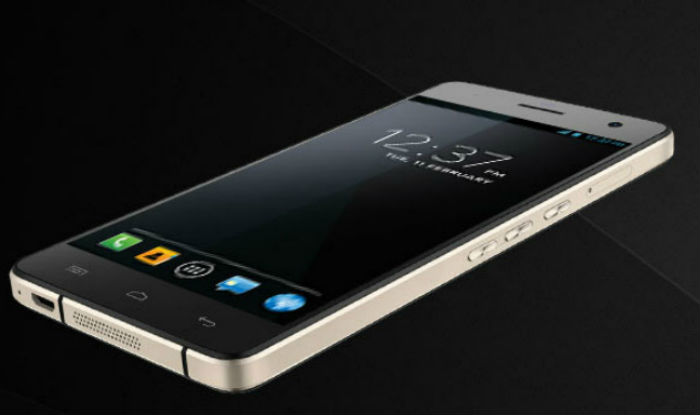
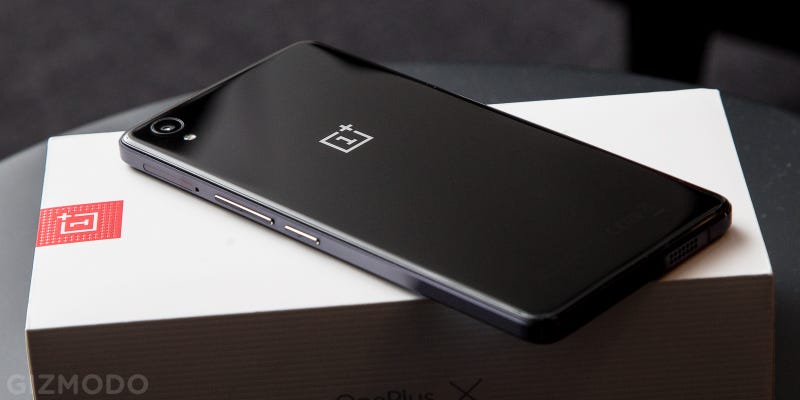
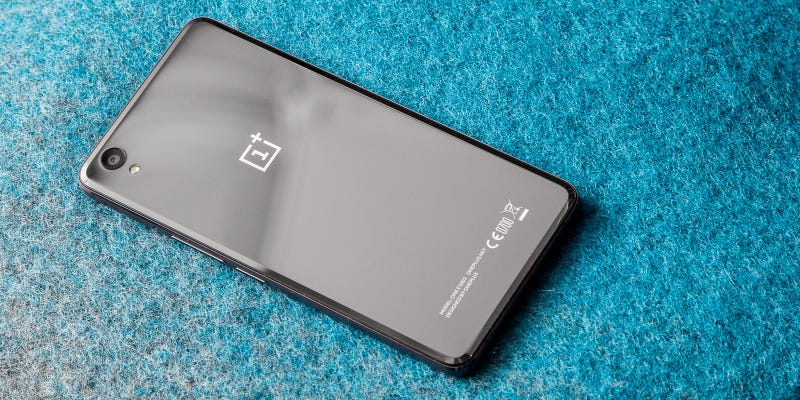
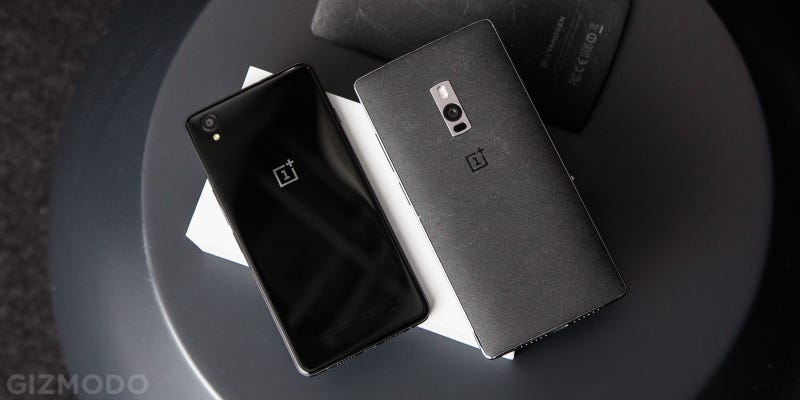

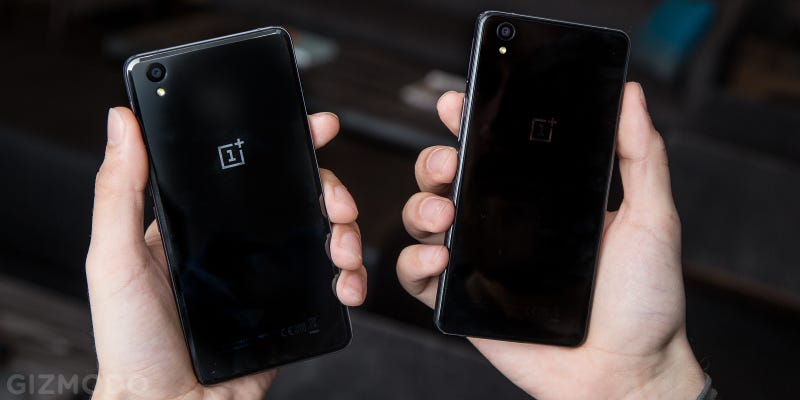
 Specs at a glance: HTC One A9 Screen 5-inch, 1080p AMOLED, Gorilla Glass 4 OS Android 6.0 Marshmallow CPU Snapdragon 617, 64-bit octa-core Cortex A53: 4 cores @ 1.5GHz; 4 cores @ 1.2GHz RAM 2GB (3GB in 32GB storage model) GPU Qualcomm Adreno 405 GPU Storage 16GB or 32GB, plus micro SD expansion Networking 802.11 Wi-Fi a/b/g/n/ac (2.4 & 5 GHz) Ports Micro USB, headphone jack Camera 12MP rear camera, 4MP HTC ultrapixel selfie camera Size 145.75mm length, 70.8mm width, 7.26mm depth Weight 143g Battery 2150mAh Network Bands 2G: 850/900/1800/1900MHz, 3G: 850/900/AWS/1900/2100MHz, 4G (EMEA/Asia): FDD bands 1, 3, 5, 7, 8, 20, 28, TDD bands 38, 40, 41, 4G (USA): FDD bands 2, 3, 4, 5, 7, 12, 13, 17, 29 Other perks Quick Charge 3.0 support, 24-bit DSP and DAC, RAW image support Price $399 direct from HTC.com (introductory period only; $400 thereafter) / £430
Specs at a glance: HTC One A9 Screen 5-inch, 1080p AMOLED, Gorilla Glass 4 OS Android 6.0 Marshmallow CPU Snapdragon 617, 64-bit octa-core Cortex A53: 4 cores @ 1.5GHz; 4 cores @ 1.2GHz RAM 2GB (3GB in 32GB storage model) GPU Qualcomm Adreno 405 GPU Storage 16GB or 32GB, plus micro SD expansion Networking 802.11 Wi-Fi a/b/g/n/ac (2.4 & 5 GHz) Ports Micro USB, headphone jack Camera 12MP rear camera, 4MP HTC ultrapixel selfie camera Size 145.75mm length, 70.8mm width, 7.26mm depth Weight 143g Battery 2150mAh Network Bands 2G: 850/900/1800/1900MHz, 3G: 850/900/AWS/1900/2100MHz, 4G (EMEA/Asia): FDD bands 1, 3, 5, 7, 8, 20, 28, TDD bands 38, 40, 41, 4G (USA): FDD bands 2, 3, 4, 5, 7, 12, 13, 17, 29 Other perks Quick Charge 3.0 support, 24-bit DSP and DAC, RAW image support Price $399 direct from HTC.com (introductory period only; $400 thereafter) / £430 























 Android 6.0 Marshmallow, thoroughly reviewed
Android 6.0 Marshmallow, thoroughly reviewed 















































 Nexus 5X and Nexus 6P review: The true flagships of the Android ecosystem
Nexus 5X and Nexus 6P review: The true flagships of the Android ecosystem